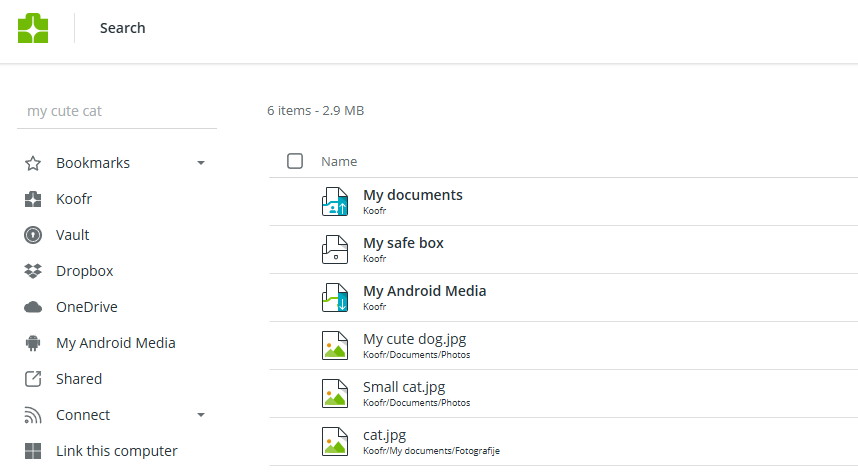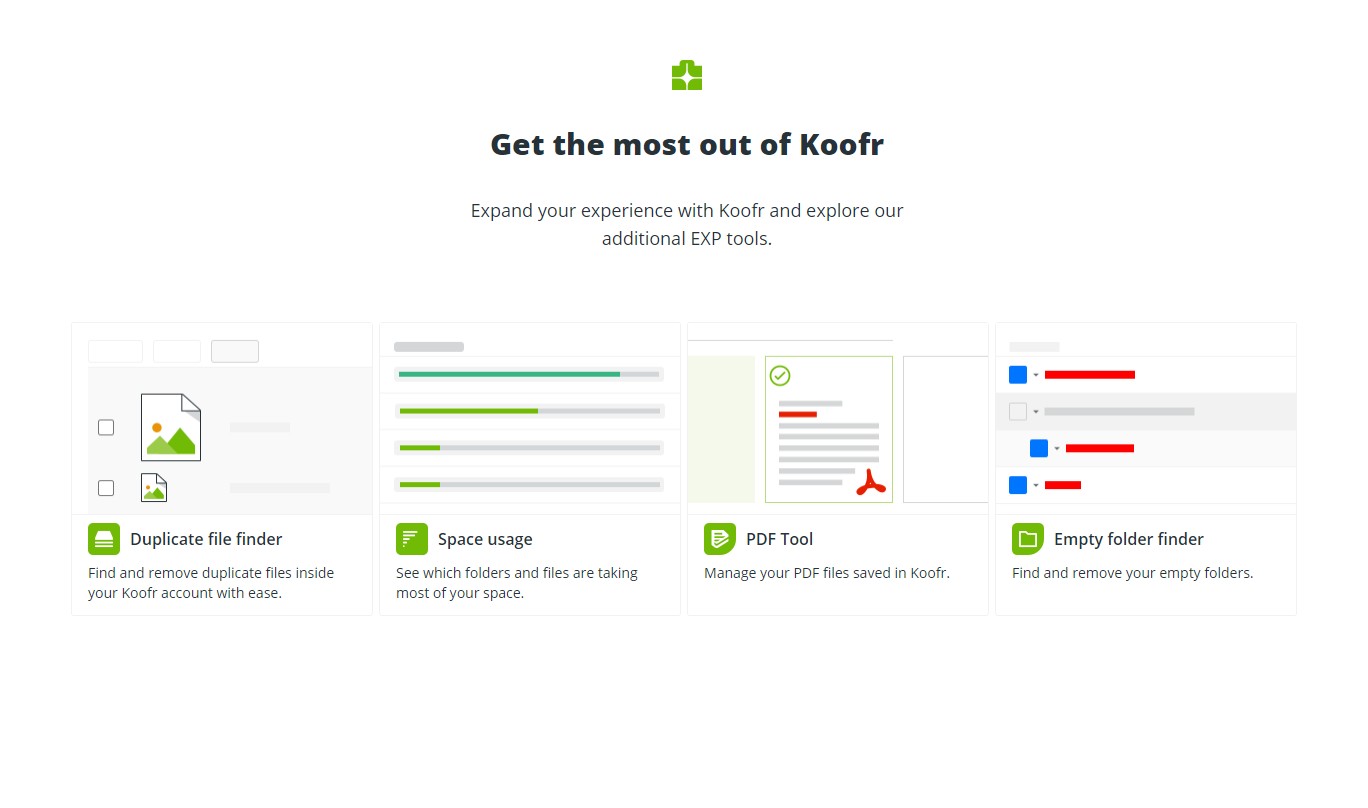4 useful tips for organizing your files
Discover 4 useful tips for organising your files: build a folder system, name files properly, delete digital clutter, and maintain a cloud-first workflow. Includes Koofr tools to simplify storage, backups, and everyday organisation.
Written by human for humans
If you’ve ever spent ten minutes digging through folders trying to find one important file — a contract, a tax document, or that one irreplaceable baby photo — you already know the feeling. It starts as a quick search, then escalates into a full-blown digital panic.
You try every keyword you can think of. You open random folders. You find a copy of something you forgot existed from 2019. You wonder whether you accidentally deleted it. And just as you’re losing hope, a “Storage Full” notification pops up to really add insult to injury.
The good news? It doesn’t have to be like this.
Digital organisation isn’t just about tidying up. It’s about reducing stress, clearing mental clutter, and saving a significant amount of time every week. The right system means you can find what you need in seconds — and you stop carrying that low-level anxiety that something important might be lost forever.
Koofr. Where your files are organised.
In the next paragraphs, we’ll share four proven steps to master your files, using modern cloud tools that do 90% of the hard work for you. And to make it practical, we’ll also show how Koofr cloud storage can act as your digital Command Centre: a place where your files are not only stored but also actively organised, protected, and easy to work with in real-time.
1. Build a Filing System That Actually Works
Let’s start with the foundation: your folder structure. A clean system always follows a simple hierarchy:
Root folders → Subfolders → Archives
It’s logical, easy to maintain, and scalable, meaning it works whether you have 200 files or 200,000 files.

Why saving files to “Desktop” is a trap
Desktop on your computer is where files go to die. It starts as temporary, but quickly turns into a messy graveyard of screenshots, random PDFs, versions of documents labelled “final final”, and things you’re too scared to delete. The fix is simple: stop using Desktop as a filing cabinet.
A simple structure you can start using today
Try splitting your digital life into three core folders:
- Work
- Personal
- Finances
Inside those, keep subfolders tidy and specific (Projects, Travel, Receipts, Legal, etc.). And here’s the secret that makes it all stay clean: Move completed work into an Archive folder. This way, your active folders stay small and fast, while everything older is still stored safely and searchable.
Make it effortless with Koofr cloud storage
Once your structure exists, Koofr makes it easier to keep everything in the right place.
- Back up your computer using Duplicati: This connects your local files to your cloud system, so what’s on your laptop doesn’t vanish if it breaks, gets stolen, or fails.
- Koofr Automatic Mobile Backup: Every photo you take is instantly saved to the cloud — no cable, no “I’ll do it later”, no accidental loss.
- Multi-Cloud Connection: If your files are scattered across Google Drive, Dropbox, or OneDrive, you don’t need to manage them separately. Koofr can connect them so you can access and organise everything from one dashboard.
2. Name and Label Your Files Like a Pro
You can have perfect folders and still lose files. Why? Because file names like: IMG_554.jpg, scan00013.pdf, Document (2).docx, are invisible. Even the best search tool can’t save you if the file name doesn’t contain meaningful words.
Compare these two:
❌ IMG_554.jpg
✅ 2024-05-Paris-Vacation-01.jpg
The second one is not only easy to recognise, but it’s also instantly searchable. You can search “Paris”, “2024” or “Vacation”.

Read more about searching for files in Koofr in our blog posts: Searching for files in Koofr and Koofr search tips and tricks.
The secret weapon: ISO date format
Use YYYY-MM-DD at the start of file names. It’s the only format that stays in chronological order when sorted alphabetically, which means: no chaos, no confusion and no guessing.
Examples:
2025-01-15-Tax-Return.pdf
2024-11-03-Client-Contract-Signed.pdf
Speed naming and renaming up inside Koofr
Koofr helps turn naming from a chore into something fast and satisfying.
- Koofr Multi Rename Tool: Instead of renaming files one-by-one, you can select dozens (even hundreds) and apply a clean naming format in one go.
- Labels: A New Way to Organise Your Files in Koofr: Perfect for visual learners, and brilliant for status tracking. For example: Magenta: Urgent / To-Do, Green: Finished, Blue: Private. This adds a layer of organisation that plain text simply can’t match, especially if you manage lots of projects or shared folders.
3. Delete what you don't need
This one is essential: you cannot organise digital clutter. If your storage is packed with files you’ll never use again, you’re not organising, you’re rearranging junk. Most people lose space (and time) to:
- old downloads
- duplicates
- forgotten videos
- blurry photos
- documents saved five times in different places
Read more on how to declutter your digital files in our blog posts:
Start with a “High-Impact Audit”
Don’t start by deleting one photo at a time. Start where it matters:
- Biggest files
- Downloads folder
- Old videos
- Repeated documents
You’ll feel immediate relief because you’re reclaiming the most space with the least effort.
The 1-Year Rule
If you haven’t opened it in a year and it isn’t important for legal/tax reasons, delete it. You are not “being careful” by keeping everything forever - you’re building a digital landfill.
Koofr tools that make deleting easy
Koofr doesn’t just store files — it helps you clean your storage intelligently.
- Koofr Space Usage Tool: This gives you a clear visual overview of what’s taking up space. Many people are shocked when they see that 80% of storage is taken up by old videos or forgotten backups.
- Koofr Duplicate Finder: Manual duplicate deletion is soul-destroying. This tool finds identical files (often photos saved twice or files re-downloaded), so you can clean up quickly.
- Koofr Empty Folder Finder: After a big delete, empty “ghost folders” remain and clutter your tree. This tool clears them out automatically, so your folder structure stays clean.

Read more about the Koofr Extra tools in our blog post: Organise your account with Koofr Extra Tools
4. Stick to the System with cloud-first habits
This is where most people fail, not because they don’t know what to do, but because they don’t keep doing it. An organised system only works if you consistently stay inside it. The biggest mistake? Downloading a file, editing it locally, and creating “versions” that never go back to the cloud.
That’s how you end up with:
- proposal.docx
- proposal_v2.docx
- proposal_final.docx
- proposal_final_final.docx
Adopt a “Cloud-First” workflow
Stop the download → edit → upload cycle. Work directly in the cloud. Your files stay in the right place, version history stays clean, and you always know you’re editing the latest version.
Koofr features that support a better workflow
Koofr makes it easy to stay organised because you can actually work inside your system.
- MS Office for Web: Open Word or Excel directly in your browser and edit your files instantly — every change saves back into the organised folder automatically.
- Edit Your Photos Online with Koofr's Image Editor: Need a quick crop or adjustment? You don’t need Photoshop or a download. Do it inside your Koofr cloud storage account and keep your files tidy.
- Instagram/Facebook Media Transfer: Do a monthly “memory sync”: pull your social media photos into your cloud archive so everything sits safely alongside your private photos.
- PDF Tool: Instead of 10 separate scans of receipts, merge them into one organised PDF. Your Finances folder stays clean and professional.
- Easy Sharing in Koofr: Once your system is organised, sharing becomes effortless. Sending a neat folder link looks more professional (and is far less messy) than email attachments.

Conclusion: Organisation That Actually Sticks
File organisation isn’t about becoming perfect. It’s about building a system you can maintain — one that reduces stress and makes your digital life easier.
And the best part is, you don’t need to do it all manually. When Koofr is your digital Command Centre, your organisation becomes something your storage helps with, not something you constantly battle.
Koofr. Work smarter, not harder.
If you’re ready to start, pick just one step today: delete 10 unnecessary files, rename one folder properly, or set up your core structure. These are small actions that offer a huge long-term payoff.
Want to talk to us? Join our growing Reddit community!


